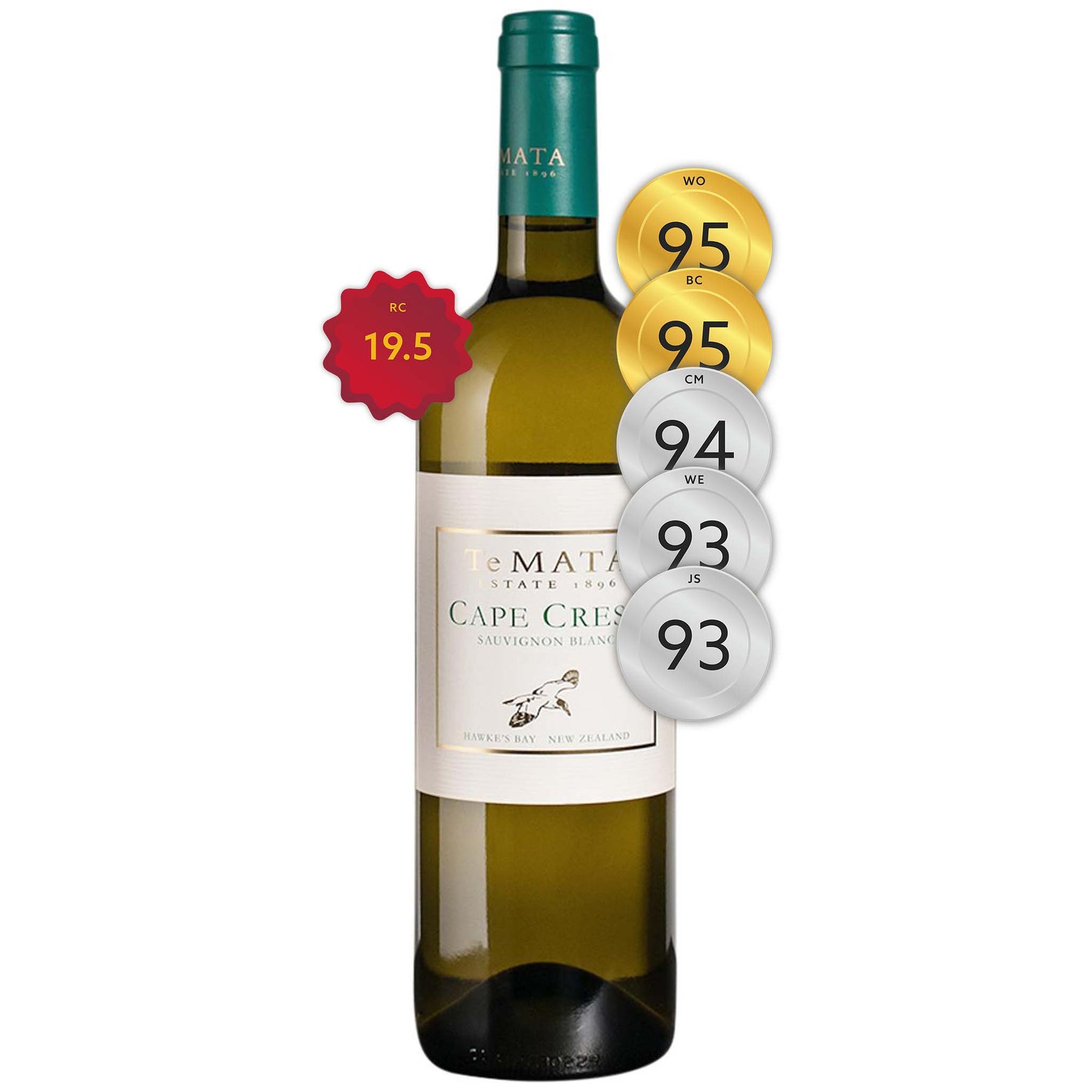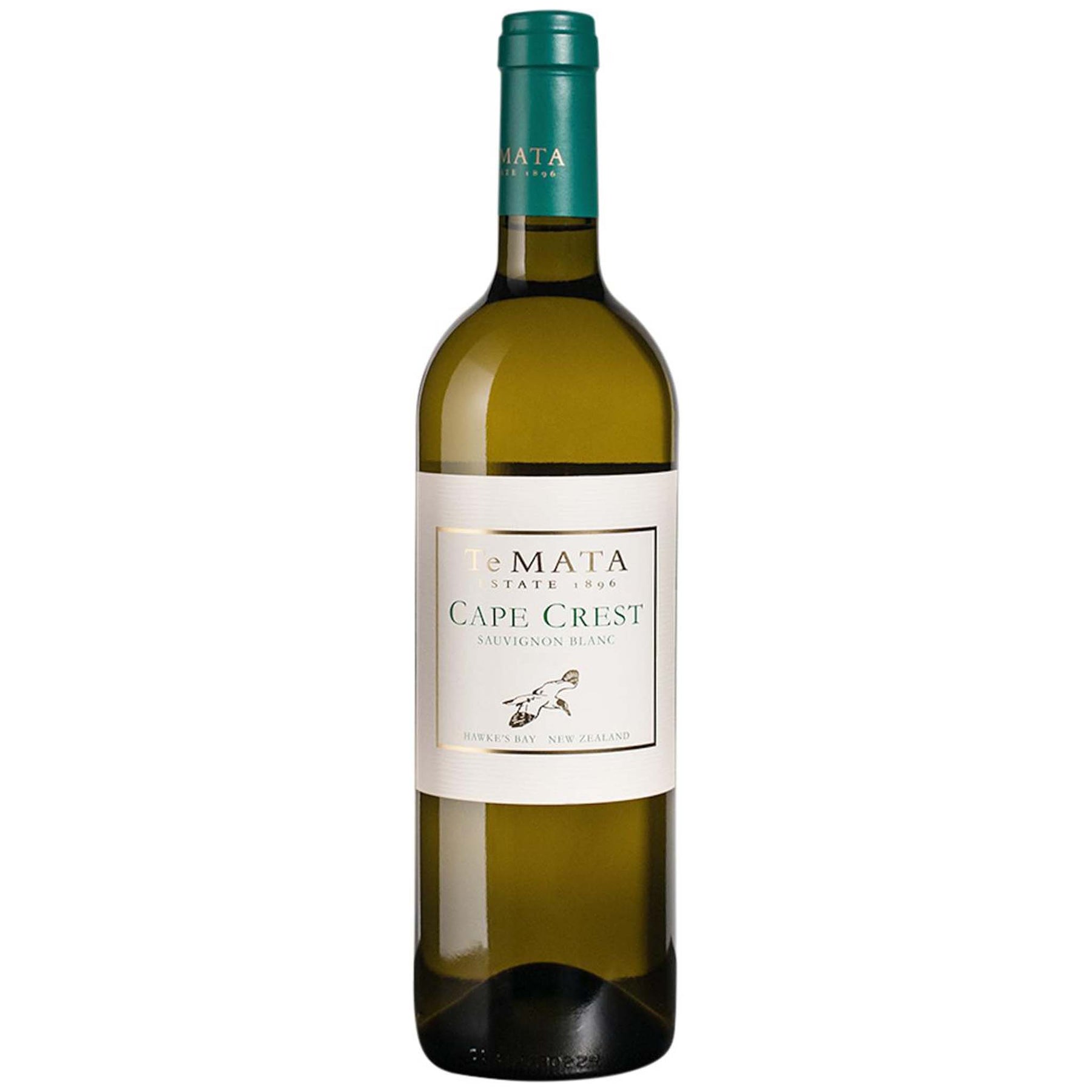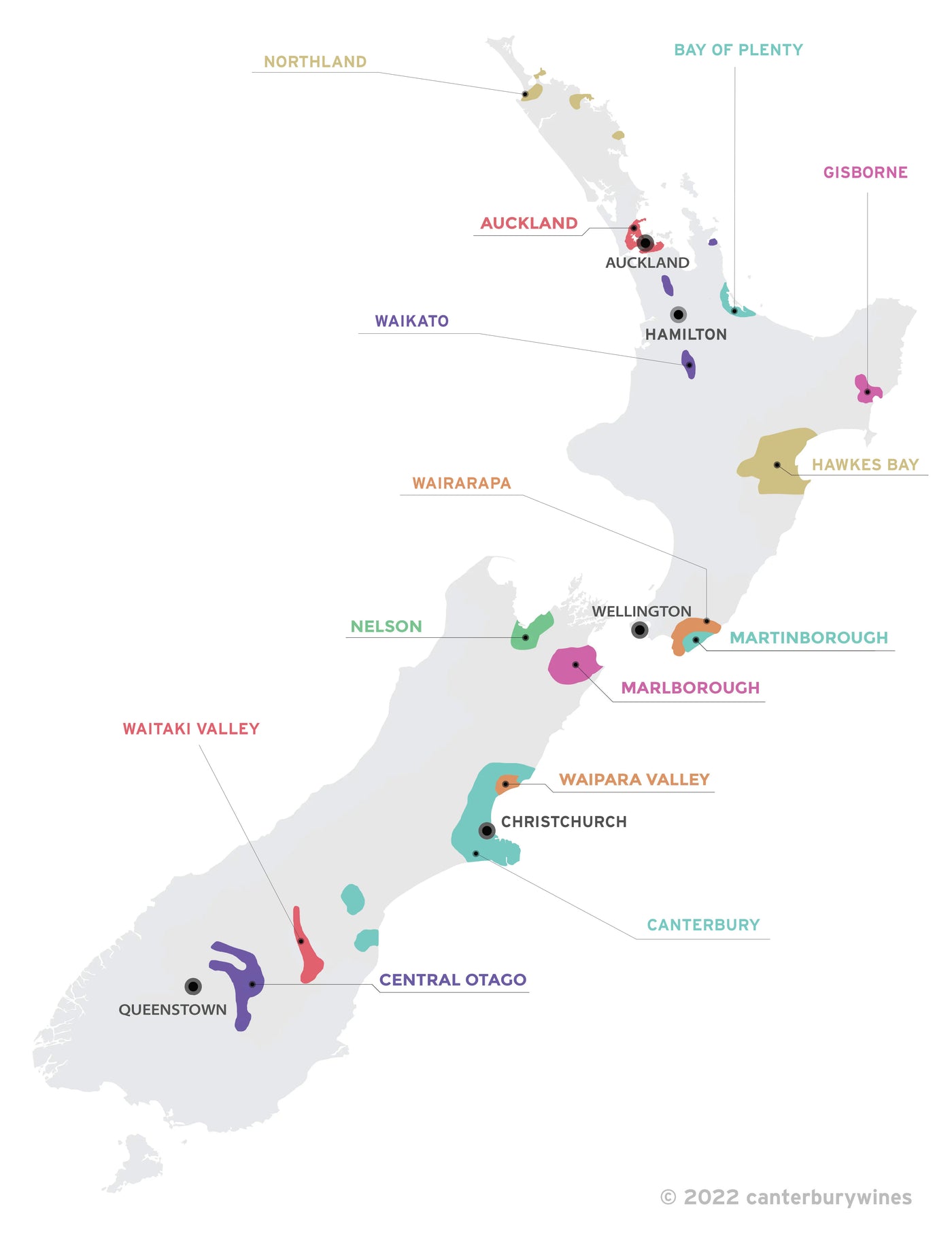

Te Mata Estate Cape Crest Sauvignon Blanc 2013
Style: White Wine
Closure: Cork
Te Mata Estate Cape Crest Sauvignon Blanc 2013
Warehouse
34 Redland Drive
Vermont VIC 3133
Australia
Critic Score: 19.5/20 and 95
Alcohol: 14.0%
Size: 750 ml
Drink by: 2027
"Te Mata's Cape Crest aligns with the Bordeaux model of dry, oak-influenced, ageworthy Sauvignon Blanc – and absolutely bears comparison with the great whites of Pessac-Léognan and Graves." Richard Hemming MW
The 2013 Cape Crest is a blend of predominantly Sauvignon Blanc (85%) with small quantities of Semillon and Sauvignon Gris that was fermented in new and seasoned French oak barrels, then matured on lees for eight months with regular lees stirring. The fruit comes from the Isosceles vineyard in the Bridge Pa subregion which was planted in 1990 and 2000. To quote Richard Hemming MW, "The result is a lip-smacking combo of butter, cream and spice that comes from from the oak and malolactic conversion, alongside box-fresh citric fruit and leafy notes that are the hallmarks of the variety."
"Medium-full bodied, rich and packed ripe stonefruit flavours are entwined with nectarines and peaches, unfolding herbs, spices and nuts. The mouthfeel is luscious and creamy in texture, but balanced by a fine line of phenolics and underlying lacy acid cut. The richness and waves of flavour are carried to a very long, lingering finish. This is a beautifully complex, layered barrel-influenced Sauvignon Blanc." Raymond Chan
Te Mata Estate Winery
Expert reviews
"85% Sauvignon Blanc, 9% Semillon and 6% Sauvignon Gris, given skin contact and fully barrel-fermented to 14.0% alc., the wine aged 8 months in new and seasoned French, undergoing batonnage. Bright, light, golden-straw colour with some depth. The nose is softly packed with layers of ripe green stonefruits, nectarines, greengages and pineapple, along with tropical fruits, melded with nutty and creamy barrel-ferment notes. Dry to taste and medium-full bodied, rich and packed ripe stonefruit flavours are entwined with nectarines and peaches, unfolding herbs, spices and nuts. The mouthfeel is luscious and creamy in texture, but balanced by a fine line of phenolics and underlying lacy acid cut. The richness and waves of flavour are carried to a very long, lingering finish. This is a beautifully complex, layered barrel-influenced Sauvignon Blanc." Raymond Chan - 19.5-/20 points ★★★★★
"It is intensely aromatic on the nose displaying grapefruit, flint, peach and dried herb characters with subtle nutty complexity. The palate is concentrated and compact, and offers wonderful explosion of flavours, finishing superbly long and mouth-watering. The juice from hand-picked grapes were fermented in new and seasoned French oak barrels, then matured on lees for eight months with regular lees stirring. A blend of 85% Sauvignon Blanc, 9% Semillon, 6% Sauvignon Gris. At its best: 2017 to 2025." Sam Kim, Wine Orbit – 95 points
"Weighty Sauvignon Blanc with nectarine, apple, mineral and slight gunflint characters. Weighty, complex wine that's about as good as it gets in Hawke's Bay." Bob Campbell, The Real Review - 95 points
"There's some sauvignon gris and semillon in the mix. The wine has been made more or less identically since its inception. Aged on lees for around eight months in new and old oak. Pretty perfume showing the comely curves of oak handling and lees work, sweet with marzipan wafts and spiked with toasty notes buoyed with fresh cut stone fruit. Smells fancy. Tightly wound in the palate, drags long with some puffs of chalk-like minerality, shows some cedary flavour with green apple acidity frisking up the wine. Fruit sweetness rolls right through and out the back end. Classy stuff. Drink: 2015 - 2022." Campbell Mattinson, The Wine Front - 94 points
"This has come to epitomize the Hawke's Bay style of Sauvignon Blanc, typical in it's ripe fruit and oak treatment. Hints of vanilla and cedar frame passion fruit and pink grapefruit notes, then leave a lingering impression of Creamsicle behind on the silky-textured finish." Joe Czerwinski, Wine Enthusiast - 93 points
"Hawke's Bay doing Sauvignon Blanc? Yes indeedy. This is a great food wine with a rich mid palate and lovely line. It has an attractive perfume, reminiscent of blackcurrant and grass, and some nutty nuances from 25% new oak. High level of fruit concentration suggestive of low yields. zesty acidity leaves a crisp finish." James Suckling, JamesSuckling.com - 93 points
About Cape Crest
 Nick Buck discusses Te Mata Estate Cape Crest (click on image to play video)
Nick Buck discusses Te Mata Estate Cape Crest (click on image to play video)
The following article by Richard Hemming MW appeared in jancisrobinson.com
Most Sauvignon Blanc from New Zealand follows a tried-and-tested formula, and while its global popularity seems undimmed there are few that appeal to the highly engaged wine drinker. But not all Sauvignon Blancs are made equal; you say tomato, I say Te Mata.
Rather than the Marlborough model of gooseberries and grassiness, Te Mata's Cape Crest aligns with the Bordeaux model of dry, oak-influenced, ageworthy Sauvignon Blanc – and absolutely bears comparison with the great whites of Pessac-Léognan and Graves.
The 2020 vintage is a blend of 85% Sauvignon Blanc, 9% Sémillon and 6% Sauvignon Gris, fermented and matured in French oak barriques (of which 30% were new) for 11 months, which is very much the traditional recipe for the style. The result is a lip-smacking combo of butter, cream and spice that comes from from the oak and malolactic conversion, alongside box-fresh citric fruit and leafy notes that are the hallmarks of the variety.
Te Mata are best known for their reds, especially the much-admired Coleraine Bordeaux blend, but when tasting their range recently it was Cape Crest that stood out for me. Not only are the flavours both utterly delicious and wholly representative of an underrated style, but it also has a beguiling waxiness that would make it an ideal partner for many types of dish. I can imagine it holding up equally well to seafood salads, creamy sauces, or even local lamb cooked with Moroccan spices.

The fruit comes from their vineyards in the Bridge Pa subregion, pictured above, which were planted in 1990 and 2000 – relatively recent considering Te Mata's first vines were planted in 1892. The name Cape Crest, incidentally, is a reference to the most southerly point of Hawke's Bay, home to a colony of gannets, one of which adorns the label. The first vintage was 1984 and this wine was, most unusually for a New Zealand white, bottled exclusively under cork until the 2020 vintage – very bordelais!
I asked the team at Te Mata about this and senior winemaker Phil Brodie responded: 'We have gone to screwcap with Cape Crest from the 2020 vintage. The winemaking finishes the day the customer opens the bottle. We love Cape Crest in its youth, but also with bottle age. We have our own bottling line and started a screwcap closure trial 15 years ago looking at different screwcap brands having different wad compositions with varying oxygen transmission rates (OTRs). We then analysed and tasted the wines over the years to see how they evolved aromatically and texturally before committing to a particular brand and wad.'
Commercial sales manager Vince Labat adds, 'We went with a 50/50 screwcap/cork mix for vintage 2020 and 2021. We are transitioning some markets across to the screwcap who have long had the cork. Hence taking this approach. It has been well accepted so as of the 2022 vintage it will be 100% screwcap.'
Te Mata's own cellaring guide suggests the wine can last for 20 years – and I wouldn't disagree. Great oaked Sauvignon Blanc is certainly one of the few great white wines that can benefit from maturity, so don't let age dissuade you.
About the winery

Te Mata Estate was established in 1896, specialising in high-quality wines of classical style. The winery remains family owned, producing internationally recognized wines exclusively from its Hawke's Bay vineyards.
"New Zealand's first growth" - Andy Howard MW, Decanter Magazine
"A national treasure" - Jancis Robinson MW
"New Zealand's greatest winery" - Robert Parker's Wine Advocate
Te Mata Estate was originally part of Te Mata Station, a large pastoral land-holding established by English immigrant, John Chambers, in 1854. After returning from France, John Chamber's third son, Bernard, had the idea to plant vineyards on the north-facing hills around Havelock North. In 1892 he planted vines on three parcels of hillside land above the homestead and began converting the original stables to ferment and mature the wines. The first vintage wines were released in 1986. Today, Te Mata Estate still uses those same three vineyards.
The Chambers family sold the property in 1919. The property had two other owners until John and Wendy Buck acquired Te Mata Estate in 1978 and instigated a twenty-year development program, which commenced with the restoration of the original winery building and the replanting of all of the original vineyards. In addition, new vineyard sites were acquired in the Bridge Pa, Gimblett Gravels and Dartmoor Valley sub-regions of Hawke's Bay (refer map below). The Buck family have been producing Te Mata wines ever since. The success of Te Mata's wines in the '80s is credited with sparking the revival of Hawke's Bay as a top wine region.

Te Mata Estate Winery and Hawke's Bay sub-regions

New Zealand
New Zealand is home to more than 700 wineries across 14 wine regions. The regions are Auckland, Bay of Plenty, Canterbury, Central Otago, Gisborne, Hawkes Bay, Marlborough, Martinborough*, Nelson, Northland, Waikato, Waipara Valley, Wairarapa and Waitaki Valley. * Martinborough is a sub-region of Wairarapa, however, as it is world renowned it is considered here to be a region to avoid confusion.
The wine regions in New Zealand stretch from latitudes 36°S (Northland) in the north (comparable in latitude to Jerez, Spain), to 45°S (Central Otago) in the south (comparable in latitude to Bordeaux, France). New Zealand's climate is maritime, producing cooler summers and milder winters than would be expected at similar latitudes in Europe.
Viticulture in New Zealand dates back to 1836 when British resident James Busby produced wine in the far north, but it wasn't until 1985 that the wine industry came of age when Cloudy Bay Sauvignon Blanc garnered international attention and critical acclaim.
New Zealand is internationally renowned for Sauvignon Blanc (particularly from Marlborough), Pinot Noir (Central Otago, Martinborough and Waipara Valley), Chardonnay, Bordeaux-style blends of mainly Merlot and Cabernet Sauvignon (Hawkes Bay) and Syrah (Hawkes Bay). Sauvignon Blanc accounts for 63% of the area of the national vineyard, followed by Pinot Noir (14%), Chardonnay (8%), Pinot Gris (7%) and Merlot (3%).


